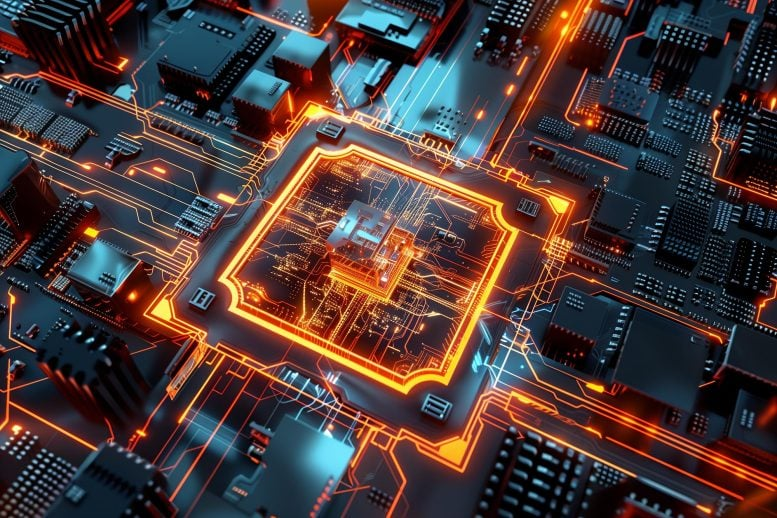AI is the ultimate tool for laboratories. But it requires lots of calculation power.
The advancement of self-driving labs in chemistry and materials science, employing AI and automation, promises to revolutionize research by accelerating the discovery of new molecules and materials. Milad Abolhasani highlights the need for standardized definitions and performance metrics to compare and improve these technologies effectively. Credit: SciTechDaily.com (ScitechDaily, Revolutionizing Research: How AI-Driven Chemistry Labs Are Redefining Discovery)
The AI is a revolutionary tool for many things. It's powerful even if there are no quantum processors. That is the beginning of a new era of technology for civil and military purposes. The AI-controlled laboratories can create new chemicals and new materials. And the AI can also create programming code faster than any programmer can do.
The new AI can create images from text and music. And the AI can watch your body language and see if you lie. Those systems are coming, and that is the thing that we must just accept.
Things like nanomachines can operate as well as independently as full-scale machines. However, they require new types of microchips that can drive complicated code. But if those microprocessors are used the nano-machine swarm can operate as a regular drone swarm that uses non-centralized calculation.
Things like nanomachines require new types of microprocessors. Those nanomachines can detect and remove cancer and dirt from the human body. But those nanomachines require new types of microprocessors. In nanotechnology is a danger. That electricity jumps over the switches. The nanomachines take their electricity from radio waves. Or even from the human nervous system.
In visions, nanorobots can even replace the human immune system and filter carbon dioxide off the hemoglobin in the human blood system. The use of nanotechnology requires new types of AI-based laboratories. And in those laboratories, the AI makes things where it is best. It can control and observe large-scale structures.
AI can create new types of materials and create full-scale documentation of those processes. The system can collect precise and accurate information on physical and chemical conditions. And it can filter information extremely fast. The AI can search and collect data from multiple places, and then it can find things like similarities from the DNA.
The AI can search cancer genomes. But it also can search for things like similarities in the DNA samples taken from people creative people. And that thing makes it possible to position the genome that connects creative people. AI-controlled nanotechnology makes it possible to create synthetic, productive DNA. And then that genome can be transported to the human body. This makes it possible that humans can connect new abilities to themselves.
"A new chip developed by Penn Engineers uses light to accelerate AI training, offering faster processing and reduced energy consumption while enhancing data privacy. (Artist’s concept.) Credit: SciTechDaily.com" (ScitechDaily, At the Speed of Light: Unveiling the Chip That’s Reimagining AI Processing)
The new photonic processors are tools for running the new AI.
The new AI-based search engines that generate texts from free Internet sources require new types of microchips. The new microchips are more energy-friendly than previous systems. The problem with AI and especially creative AI is that the system requires lots of calculation power. And that causes situations where microprocessors use their full power all the time.
The high temperature causes a situation in which the oscillation in wires causes resistance. And that slows the microchip. The high-power and fast microchips are required, when developers use the AI for generating images and programs using this tool. The AI makes the things like coding projects more effective. And that thing means that it is a useful technology, in the hands of people who know what they do.
The idea of creative AI is that the server interacts with the client. And that thing causes a situation where the client requires more computer power. This is the biggest difference between AI and regular PHP code. In regular homepages and web-based applications, the server system runs the entire code in the server. And that means the client doesn't need so much processor power. The client gives a mission to the server, and then the server runs the code and delivers the answer.
In creative systems, the AI makes non-stop data exchange with the server. When the creative system interacts the system delivers an answer to the client, and then the the client takes the server's role. It returns the answer to the server and says. If there is needed something more. And that requires more processor power.
This text was made using Grammarly. And in that system, you can see how the system interacts with the server. The system sends text to the server, and then the server makes proposals. On how to correct those errors. And text is an easy thing for AI. Graphics like images are more difficult. And they require more data handling and transport capacity.
There is one version of how to make this kind of AI that requires less computer power. In that system, the client will transfer responsibility to two server systems. Then those servers make the data transfer between each other. In that process, the client outsources the entire data-handling process to the servers. In that model, the user can check the results. While the task is running. Then user can give more orders to AI or the user can accept the result. That thing is the tool that can make many new things.
https://scitechdaily.com/at-the-speed-of-light-unveiling-the-chip-thats-reimagining-ai-processing/
https://scitechdaily.com/revolutionizing-research-how-ai-driven-chemistry-labs-are-redefining-discovery/






No comments:
Post a Comment
Note: Only a member of this blog may post a comment.